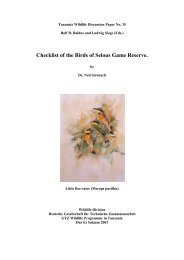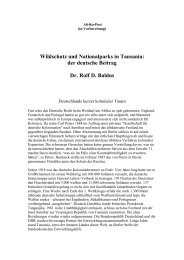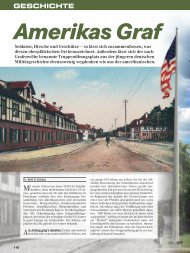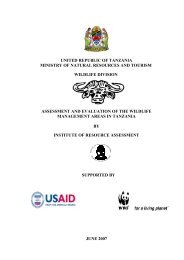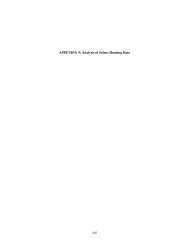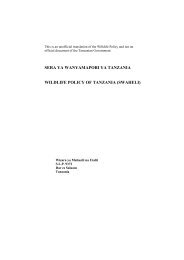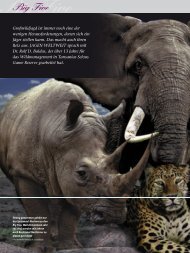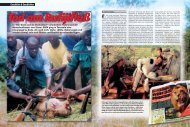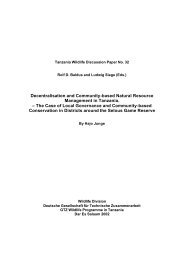African Indaba Articles - wildlife-baldus.com
African Indaba Articles - wildlife-baldus.com
African Indaba Articles - wildlife-baldus.com
Create successful ePaper yourself
Turn your PDF publications into a flip-book with our unique Google optimized e-Paper software.
Both types of area contained much higher densities of mammals than Game Controlled Areas or Open Areasthat also sanction tourist hunting but that allow settlement and cattle grazing and resident hunting as well.This shows that it is not tourist hunting itself that conserves mammals but it is the absence of people living inGame Reserves and National Parks or perhaps the absence of resident hunters that are the key.We also looked at the health of vegetation in different types of protected area using satellite imagery. Whenwe divided up pixels in Tanzania according to whether they were in National Parks, Game Reserves, ForestReserves, Game Controlled areas or Open Areas, we found that National Parks and Game Reservesshowed increases in greenness during the 1980 and 1990s. Thus Game Reserves set aside for huntingblocks help to keep habitats healthy as do National Parks. Game Controlled Areas and Forest Reserves onthe other hand suffered great habitat degradation perhaps because they were having trees removed fromthem during this period of time. Once again, this research shows that excluding certain activities, such astree cutting or resident hunting, or excluding people from areas is the key to conserving habitats.In short, if tourist hunting is ac<strong>com</strong>panied by laws, which forbid other activities, and if these laws areenforced, as they are in Game Reserves, then legal hunting benefits animal and plant <strong>com</strong>munities. Whenactivities are allowed and when there is no policing, as in Game Controlled Areas due to lack of funds, thentourist hunting does not help conservation.Baldus: This brings me to your earlier point. You say the effects of legal hunting on <strong>wildlife</strong> can virtually bedisregarded as <strong>com</strong>pared to illegal hunting. Can you elaborate on this? And does legal hunting and thefinancial returns from it have any effect on the illegal activities?Caro: Each year animals are killed by people both legally and illegally in Tanzania. Legal hunting is carriedout by residents and tourists who obtain licenses to shoot a small number of animals, as well as in croppingschemes. Illegal hunting is carried out by people who have no permits at all, but also by tourists andresidents who have obtained permits to shoot a few animals but who take more than they are allowed.Let's go through these one by one bearing in mind that there is little information on how many animals arekilled by illegal methods. First, a hunter may kill an animal having acquired licenses. While such hunting islegal, the quotas allocated for legal hunting are based on educated guesswork because we do not haveadequate information on the size of most animal populations in the country.Thus owners of a hunting block may be allocated a quota to shoot too many individual animals – say toomany lions in a given year. In practice, the Wildlife Department usually sets quotas based on what the quotawas last year. In an attempt to help the Wildlife Department <strong>com</strong>e up with more informed quotas, wematched the population sizes of animals counted from aerial surveys with the tourist hunting off-take indifferent parts of the country and found that off-take was usually low - normally less than 10% of thepopulation size – so the Wildlife Department has got it just about right. Nevertheless, certain species such aseland, lion, leopard and antelope such as reedbuck were being killed at overly high rates in some areas.Hunting licenses for residents are allocated by Regional and District Game Officers. They face the sameproblem as their head office in Dar es Salaam they don't know the number of animals in areas under theirjurisdiction. These officials usually set quotas according to what they were last year as well - but no oneknows whether these are biologically correct. Near towns these quotas are on the high side because GameOfficers are "under siege" for licenses from many applicants rather than just one hunting <strong>com</strong>pany. In short,official hunting quotas at the Regional and District levels may not be set at the appropriate level to maintainanimal populations in the long term. This problem could be solved by regular monitoring of <strong>wildlife</strong>populations right across the country. It might be feasible but very expensive.Unfortunately, there is a second problem with legal hunting. This is the problem of stretching the quota.There are many ways that this is done. For example, a hunting <strong>com</strong>pany can call up the Wildlife Departmentand say that they don't have a quota to hunt leopard this year in this area, but they have a client who wouldlove to shoot one, so could head office stretch a point and sell them a license for just one animal? Anotherway this is done is if the hunting <strong>com</strong>pany has a license to shoot a leopard in one of its blocks in the west ofthe country, but it uses that license to shoot a leopard in its eastern block. Yet another way is when aresident asks a Game Officer if he could take two hartebeest instead of one because Christmas is <strong>com</strong>ingup.A third problem with legal hunting is that residents or tourists may take more animals than their quota allows.Consider a tourist hunter who shoots a male buffalo with fair-sized horns but on the last day of his safari,86



